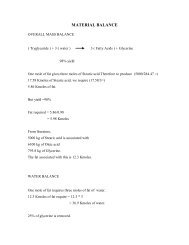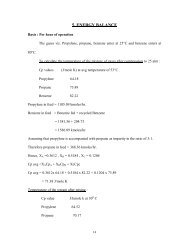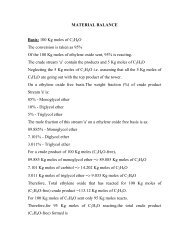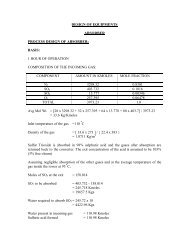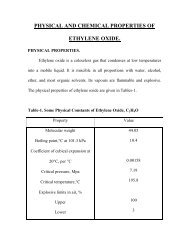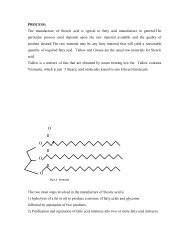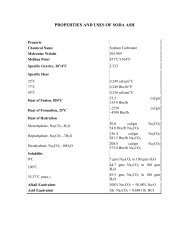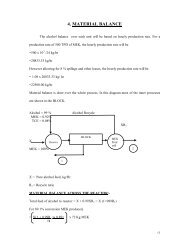Create successful ePaper yourself
Turn your PDF publications into a flip-book with our unique Google optimized e-Paper software.
Assume feed is liquid at its bubble point =231.67 deg.So q=1Slope =(q\q-1) = ∞Composition <strong>of</strong> feedNaphthalene = 0.60 mole fraction (Z f )Toluene =0.0012 mole fractionDimethyl Naphthalene =0.3988 mole fractionFeed flow rate =1253.166 Kmole\hrComposition <strong>of</strong> DistillateX n = naphthalene mole fraction in distillate =0.9911X t = toluene mole fraction in distillate = 0.0027848X m =Dimethylnaphthalene mole fraction in distillate = 6.5x10- 3Flow rate <strong>of</strong> distillate = 532.31 Kmole \ hrComposition <strong>of</strong> bottom streamX w =0.3040X m1 = 0.6959Using material balanceF =D +WFZ f =DX d +WX w1235.166 x 0.6 =532.31 x0.9911 +Wx0.3040W = 703.046 Kmole \ hrSince the amount <strong>of</strong> toluene is very less , for design the tower club toluene withnaphthalene and design the tower as binary distillation column for naphthalene anddimethylnaphthalene
From graph: minimum ( X d \R m +1) = 0.53From graph :minimum reflux = 0.87Operating reflux ratio (1.5 R m ) = 1.305L = DR= 532.31 x1.035= 694.667 Kmole \ hrG =L +d= 694.66 + 532.31= 1226.97 Kmole \hrL = L +qF= 1767.428 Kmole \hrG = G +(q-1)F= 1226.97 Kmole \hrMolecular Wt. Of feed =139.124 Kg\ KmoleENRICHING SECTIONTOPBOTTOM694.67 Liq. (Kmole \hr ) 694.671226.98 Vap. (Kmole \hr ) 1226.98128.14 (M) avg liq 139.124128.14 (M) avg. vap. 139.1240.9911 X 0.600.9911 Y 0.80217.78 T liq in deg. 231.11218.33 T vap in deg. 231.1188929.16 Liq flow rate (Kg \hr) 96645.265157225.21 Vap. Flow rate (Kg\hr) 170702.36849.30 ρ liq. (kg \m 3 ) 833.703.17 ρ vap.( kg \m 3 ) 3.22
STRIPPING SECTIONTOPBOTTOM1767.42 Liq. (Kmole \hr ) 1767.421226.98 Vap. (Kmole \hr ) 1226.98139.124 (M) avg liq 147.47133.6 (M) avg. vap. 147.40.60 X 0.30100.80 Y 0.52231.67 T liq in deg. 245.56231.11 T vap in deg. 246.11245891.65 Liq flow rate (Kg \hr) 260642.63169342.53 Vap. Flow rate (Kg\hr) 180942.74833.70 ρ liq. (kg \m 3 ) 819.693.22 ρ vap.( kg \m 3 ) 3.45⎡ L ⎤⎡ρ⎢ ⎥⎢⎣G⎦⎣ρGL⎤⎥⎦0.5= 0.03455(at top)0.5⎡ L ⎤⎡ρG⎤⎢ ⎥⎢⎥ = 0.03518 (at bottom)⎣G⎦⎣ρL ⎦Maximum at bottom <strong>of</strong> enriching section. Hence all calculations are based on propertiesat bottom <strong>of</strong> enriching section
TRAY TOWER DESIGNAssume :Plate spacing , t s = 610 mmHole diameter , d h =5 mmHole pitch , l p =15 mmTray thickness , t T =3 mmHole areaPerforated areaA=Ah =p0.10Assume equilateral triangular pitchColumn diameter, Dc:Based on entrainment flooding.ll relations from Perry’s handbook, 6 th edition.⎡ 20 ⎤Fig. 18-10 , C sb = U nf⎢⎣ σ ⎥⎦C sb∴ σU nf= 0.0883 m\s0.2= 17.29 dyn\cm= 1.3990 m\s⎡ ρg⎢⎢⎣ρl− ρg⎤⎥⎥⎦0.5ft/s.Assume U n= 0.8 U nf= 1.119 m/s.Net area for flow , A n = A c - A d
170702Vapour flow rate = = 14. 56 m 3 /s.3600 x 3.22A n = 14.56 / 1.119 = 13.159m 2 .L w weir lengthLAssume w = 0. 75D⎛ θSin ⎜⎝cL⎞⎟ =⎠ Dwc2 c22θ c = 97.2 0πD 2 cA c = = 0.78522A d = 0.0878 D c2D cA n = 0.785 D c 2 – 0.0878 D c2D c =4.34 mA c = 14.78 mA d =1.626 m 2Active area, A a = A c – 2A d =11.52 m 2 .L w = 4.43 x.75 = 3.255 mLets take 3.3 mPerforated area,A pcorrected θ c = 99.o 0 Cα = 180 - θ c = 81 0 CArea <strong>of</strong> calming + distribution zone, A czA cz =2(L w * t) , t=thicknessA cz =2(3.3 * 120* 10 -3 ) =0.792 m 2 (that is 5.3% <strong>of</strong> A c )A wz = 2πD42cα π− (D360 42c− 0.052α)360
A wz = 0.0.348m 2 . (2.3% <strong>of</strong> A c )A p = A c –2 A d – A cz - A wz= 14.56-3.552-0.198-0.348 = 10.682 m 2A h = 0.1 A p = 1.0682 m 2No. <strong>of</strong> holes, n h =1.0682π4−3( 5x10) 2= 54500holes.Weir height, h w =50 mm (atmospheric pressure)Weeping check:TOP <strong>of</strong> enriching sectionVapor flow rate = 13.77 m 3 /s ( at top)Vapor flow rate = 14.72 m 3 /s ( at bottom)A h =1.0682 m 2U n = (13.77/1.0682) = 12.89 m/s.hd= K1+ KAssume sieve plates2K 1 = 0 , K 2 = 50.8/C vA h / A a =1.0682 /11.52 =0.09t T /d h = 0.6C v = 0.75K 2 = 90.33∴ h d =90.33 x (3.17 x12.89 x12.89) \849.14∴ h d =56.0 mm2ρgρUl2h⎡ q∴ h ow = F w x 664 x ⎢⎣ L W⎤⎥⎦2388929.16q 1 ( liquid load ) = = 0. 0293600x849L w = 3.255 mm 3 /s
Lq2.5WL= 4.92 W, = 0. 75DcwF w = 1.03h ow = 25.326 mmHead loss due to bubble formation ,⎡ σhσ = 409 ⎢⎣ ρld n⎤⎥⎦⎡ 17.29 ⎤h σ= 409⎢⎣833x5⎥⎦∴ h σ = 1.69 mm liq.Now, h d + h σ = 56+1.69 = 57.69mm liq.h w + h ow =50 + 25.32 =75.32 mm(A h / A a ) = 0.09Minimum value to avoid weeping , h d + h σ = 18mm ( from fig. 18-11)Since actual >minimum there is no weepingDowncomer flooding :h dc =h t + h w + h ow + h da + h hgHydraulic gradient :h d > 2.5 h hg mmLet h hg = 0.5 mmh ds = h w + h ow +h hg /2h ow =0.9 * 664 * (0.0325\3.255) 2\3h t = h d +h 1 lh 1 L = βh ds= 27.28mmh ds = 50 +27.28 +0.5\2 =77.53 mmU a = 1.27 m/s = 4.19 ft/sρ a = 3.22 kg/m 3 = 0.2008 lb/ft 3F a =U ρa0.5g= 1.8877
β = 0.60φ = 0.2h L ’= 0.60 x77.53 = 46.518 mh f = h 1 1 / φ t = 232.59 mm.D f =(L w +D c )\2 = (4.34 +3.255) \2 =3.7625m.r h =u f =fhfD2 h +1000D1000qh 1D fff=0.2069 m.1000x0.032246.51x3.76D f= 0.184 m\sReynolds modulesN reh. =r hu fρµ10.2069x0.184x8330.0003From pg. 18-19 : f=0.031000fuh hg =grh12fLL f =D c Cos(θ c /2) = 1.396m.h hg = 0.75mm.f=105706.58(b) Loss under downcomer, h dah da = 165.2 ( q/A da ) 2Assume clearance C = 1” =25.4 mm.h ap = 77.53 – C = 52. 13 mmA da = L w h ap = 3.225 x0.05213 = 0.1681 m 2h da = 165.2 ( 0.0322/0.1681) 2= 31.64 mmh dc = h l + h w + h ow + h da + h hg
=121.82+ 50 + 27.28 + 31.64 + 0.75= 231.49 mmhh dc ’ = dc231.49= = 462. 98 mm liq.φ 0.5dct s = 610 mmAs h dc ’ < t s there is no floodingSummary <strong>of</strong> tray calculationsD c = 4.34mL w = 3.255mh w = 50 mmt s = 500 mmd h = 5 mml p = 15 mmt t = 3 mmn h = 54500
COLUMN EFFICIENCYEnriching SectionStripping SectionLiquid flow rate kmol/hr.694.67 1767.428Liq. flow rate : kg/hr. 92787.2145 253267.12Vap. flow rate : kmol/hr1226.98 1226.98Vap. flow rate : kg/hr. 163963.789 175133.63ρL(kg/m 3 ) 841.5 826.0ρV(kg/m 3 ) 3.195 3.34Tliq( o C ) 224.72 138.61Tvap( o C ) 225.12 238.66µliq, cP 0.300 0.1µvap , cP 8.48x 10- 3 .0095D L , cm 2 /s 8.8752 x 10 -5 9.204 x 10 -5D G , cm 2 /s 0.04326 0.0449σ 17.29 17.5x 0.7955 0.4505y 0.8955 0.66
Enriching sectionColumn Efficiency:(a)Point Efficiency, E OG0.776 + 0.2285hW− 0.238UNg=0. 5Nscgaρ0.5g+ 105WW = liq. flow rate = (.0.03006 /3.7625)= 8.13* 10 -3 m 3 / m.sU a = 1.273m/sh w = 50 mm , N Scg = (µ g \ρ g D g ) = 0.824N g = 1.13N L = K L aθ LK L a = ( 3.875 x 10 8 D L ) 0.5 (0.4 U a ρ 0.5 g + 0.17 )= 1.681 * 1.053= 1.771m/sθ L = (h L A a ) / (1000q)h L = ϕ e (h w + 15330 C (q \ϕ e ) 2\3C =0.327 + 0.0286exp((-0.1378 h w )C = 0.327K s = U a (ρ g \ ρ l -ρ g )K s = 0.07ϕ e =0.3303h L =332.92 mmN L = 22.14G= MLmλ M TOP = 0.5125mGLmm157225.21= =1.7688929.21λ t = 0.902M BOTTOM = 0.67λ b = 1.183
Nogλ = 1.04=1Ng1λ+NL1=0.993 + 0.046∴ N og = 0.974E OG = 1 – e -NOG = 0.6181(b) Murphree Plate Efficiency, E mvN Pe =DZE2LθLZ L = D c cos (θ L /2) = 2.792 m.D E = 6.675 * 10 -3 (U a ) 1.44 + 0.922 * 10 -4 h L – 0.00562= 6.48 x 10 -3 m 2 /sN Pe = 34.41λ E OG = 0.636EmvFrom fig. 18.29a = 1. 03E∴ E mv = 0.66OG(c) Overall column efficiency, E ocE oc =EEaMVNN=TAlog=1 + EMV[ 1+E ( λ −1)]1⎡⎢⎣1alog λψ− ψ⎤⎥⎦LG⎡ ρ⎢⎣ ρGL⎤⎥⎦0.5= 0.0348Considering 80% flooding,From fig, Ψ = 0.08
∴ E a = 0.614E oc = 0.587E oc = N t \ N AN A = 8.605 ≈ 9 traysN A = 9 traysTower height, = t s * N A= 610 * 10 -3 * 9 = 5.5m∴ H = 5.5m
STRIPPING SECTION :⎡ L ⎤⎡ρ⎢ ⎥⎢⎣G⎦⎣ρGL⎤⎥⎦0.5= 0.0902(at top)0.5⎡ L ⎤⎡ρG⎤⎢ ⎥⎢⎥ = 0.0933 (at bottom)⎣G⎦⎣ρL ⎦Maximum at bottom <strong>of</strong> stripping section. Hence all calculations are based on properties atbottom <strong>of</strong> stripping sectionAssume :Plate spacing , t s = 610 mmHole diameter , d h =5 mmHole pitch , l p =15 mmTray thickness , t T =3 mmHole areaPerforated areaA=Ah =p0.10Assume equilateral triangular pitchColumn diameter D c :Based on entrainment flooding.All relations from Perry’s handbook, 6 th edition.⎡ 20 ⎤Fig. 18-10 , C sb = U nf⎢⎣ σ ⎥⎦C sb =0.0.43 ft\s∴ σ =17.5 dyn\cmU nf = 1.232 m\sAssuming 80% floodingU n = 0.8 U nf=0.9858 m/s.0.2⎡ ρg⎢⎢⎣ρl− ρg⎤⎥⎥⎦0.5ft/s.Net area for flow , A n = A c - A d180942.74Vapour flow rate = = 14. 56m 3 /s.3600 x 3.45
A n = 14.56 / 0.98858 = 14.77m 2 .L w weir lengthLAssume w = 0. 75D⎛ θSin ⎜⎝cL⎞⎟ =⎠ Dwc2 c22θ c = 97.2 0πD 2 cA c = = 0.78522A d = 0.0878 D c2DcA n = 0.785 D c 2 – 0.0878 D c2D c =4.66 mA c = 16.61 mA d =1.85 m 2Active area, A a = A c – 2A d =12.89 m 2 .L w = 4.6 x.75 = 3.45mPerforated area,Aα = 180 – 97.2 = 82.82 0 CArea <strong>of</strong> calming + distribution zone, A czA cz =2(L w * t) , t=thicknessA cz =2(3.45 * 120* 10 -3 ) =0.828 m 2 (that is 5.05% <strong>of</strong> A c )A wz = 0.3928m 2 . (2.3% <strong>of</strong> A c )A p = A c –2 A d – A cz - A wz= 16.61-2x1.85 –0.828 –0.3928= 11.67 m 2A h = 0.1 A p = 1.167 m 2No. <strong>of</strong> holes, n h =1.167π4−3( 5x10) 2= 59468holes.Weir height , h w =50 mm (atmospheric pressure)
Weeping check :TOP<strong>of</strong> enriching sectionU n = 12.5 m/s.hd= K1+ K2ρgρUAssume sieve plates2K 1 = 0 , K 2 = 50.8/C vA h / A a =1.0682 /11.52 =0.09t T /d h = 0.6C v = 0.75K 2 = 90.33∴ h d =90.33 x (3.22 x12.5 x12.5) \833.7h d =54.5mml2h⎡ qh ow = F w x 664 x ⎢⎣ L W⎤⎥⎦24445891.65q 1 ( liquid load ) = = 0. 08193600x833.70L w = 3.255 mF w = 1.04h ow = 56.36 mmHead loss due to bubble formation ,23m 3 /s⎡ σhσ = 409 ⎢⎣ ρld n⎤⎥⎦⎡ 17.5 ⎤h σ= 409⎢⎣833.70x5⎥⎦∴h σ = 1.717mm liq.Now, h d + h σ = 54.5+1.715 = 56.25mm liq.h w + h ow =50 +56.34 =106.21 mm(A h / A a ) = 0.09Minimum value to avoid weeping , h d + h σ = 16mm ( from fig. 18-11)
Since actual >minimum there is no weepingDowncomer Floodingh dc =h t + h w + h ow + h da + h hgHydraulic gradient :h d > 2.5 h hg mmLet h hg = 0.5 mmh ds = h w + h ow +h hg /2h ow =1.03 * 664 * (0.088\3.45) 2\3= 58.68mmh ds = 50 +58.68 +0.5\2 =108.93 mmh t = h d +h 1 lh 1 L = βh dsU a = 1.13 m/s = 3.70 ft/sρ a = 3.45kg/m 3 = 0.2150lb/ft 3F a =U ρa0.5g= 1.7177β = 0.61φ = 0.22h L ’= 0.61 x1108.93= 66.26 mh f = h 1 1 / φ t = 301.18mm.D f =(L w +D c )\2 = (4.6 +3.45) \2 =4.025m.r h =u f =fhfD2 h +1000D1000qh 1D fff=0.2619m.1000x0.08866.26x4.025= 0.3311 m\sReynolds modulesN reh. =r hu fρ1µ1
0.2619x0.3311x819.69=710986.050.0001From pg. 18-19 : f=0.031000fuh hg =grh2fLfL f =D c Cos(θ c /2) = 0.3.042m.h hg = 4.02mm.(Loss under downcomer, h dah da = 165.2 ( q/A da ) 2Assume clearance C = 1” =25.4 mm.h ap = 108.93 – C = 83.23 mmA da = L w h ap = 3.45 x0.08323= 0.2945 m 2h da = 165.2 ( 0.088/0.2942) 2= 14.81 mmh dc = h l + h w + h ow + h da + h hg=109.80+ 50 + 58.68+ 14.81 + 4= 237.29 mmh dc237.29h dc ’ = = = 474. 58 mm liq.φ 0.5dct s = 610 mmAs h dc ’ < t s there is no floodingSummary <strong>of</strong> tray calculationsD c = 4.6mL w = 4.01mh w = 50 mmt s = 610 mmd h = 5 mml p = 15 mmt t = 3 mmn h = 59468holes
COLUMN EFFICIENCY 0F STRIPING SECTIONStriping section(a)Point Efficiency, E OG0.776 + 0.2285hW− 0.238UNg=0. 5Nscgaρ0.5g+ 105WW = liq. flow rate = 0.021 m 3 / m.sU a = 1.163m/sh w = 50 mm , N Scg = (µ g \ρ g D g ) = 0.834N g = 1.154N l = K L aθ LK L a = ( 3.875 x 10 8 D L ) 0.5 (0.4 U a ρ 0.5 g + 0.17 )= 1.8m/sθ L = (h L A a ) / (1000q)h L = ϕ e (h w + 15330 C (q \ϕ e ) 2\3C =0.327 + 0.0286exp((-0.1378 h w )C = 0.327K s = U a (ρ g \ ρ l -ρ g )K s = 0.0742ϕ e =0.3081h L =80.86 mmN L =21.36G= MLmλ M TOP = 0.8mGLmm157225.21= =0.988688929.21λ t =0.8164M BOTTOM = 1.6λ b = 0.9582λ = 0.88
Nog=1Ng1+λNL1=0.86695 + 0.044E OG = 1 – e -NOG = 0.66Murphree Plate Efficiency, E mvN Pe =DZE2LθLZ L = D c cos (θ L /2) = 3.04 m.D E = 6.675 * 10 -3 (U a ) 1.44 + 0.922 * 10 -4 h L – 0.00562= 6.48 x 10 -3 m 2 /sN Pe = 75.41E OG =0.64EmvFrom fig.18.29 = 1. 04EOG∴ E mv = 0.672Overall column efficiency, E ocE oc =EEaMVNN=TAlog=1 + EMV[ 1+E ( λ −1)]1⎡⎢⎣1alog λψ− ψ⎤⎥⎦0.5L ⎡ ρG⎤⎢ ⎥ = 0.038G ⎣ ρL ⎦Considering 93% flooding,From fig,Ψ = 0.093∴ E a = 0.632E oc = 0.625
E oc = N t \ N AN A = 4.8 ≈ 5 traysN A = 9 traysTower height, = t s * N A= 610 * 10 -3 * 5= 3.05m∴ H = 3.05m
Mechanical design <strong>of</strong> Distillation columnDiameter =4.6mOperating pressure =1 atm =1.032 Kg\ cm 2<strong>Design</strong> pressure = 1.1 x1.032 = 1.132 Kg\ cm 2Operating temperatur =245.5 0 C<strong>Design</strong> temperatur = 250 0 CShell material - carban steelShell – double weled but jointSkirt height =2mTray spacing = 610mmTop disengaingn space =0.3mBottom separator space = 0.4mAllowable stress = 1187 Kg\ cm 2Insulation material – asbestosDensity <strong>of</strong> insulation =575 kg\ m 3Head torsphericalMaterial –carbon steelSkirt supportHeight = 2mMaterial =carbon steelNozzlesNo. Of nozzles =5Tray sieve typeNo. Of tray =8Hole diameter =5mmThickness =3mmWeir height =50 mmMaterial for tray – stainless steel
Calculations <strong>of</strong> shell thickness :Considering the vessel as an internal pressure vessel.t s = ( PD I \2fj-P)+ Ct s = Thickness <strong>of</strong> shell (mm)P = <strong>Design</strong> pressure (kg/cm 2) =1.1362 kg/cm 2D i = Diameter <strong>of</strong> the shell (mm) = 4600mmf = Allowable /permissible tensile stress (kg/cm 2 ) = 1187C = Corrosion allowance (mm) =2mmJ = Joint Efficiency.Considering double welded bolt joints with backing stripJ = 85% = 0.85t s = 1.1362 x 4600 + 2 = 4.95 mm2(950 x 0.85)-1.1362Taking the thickness <strong>of</strong> the shell as t s = 6mmHead shallow dished & torispherical head.t h = PR c W2fJR c = Crown radius = outer diameter <strong>of</strong> the shell = 4600+ 2(6) =4612mmR L = knuckle radius = 0.06 R cW= Stress intensification factorW =0.25 ( 3+ (Rc\Rk) 0.5t h = 1.1362x4612x1.77 = 4.59mm2x1187x0.85Thickness <strong>of</strong> head is t h =6mm =0.236 inchesWeight <strong>of</strong> head:
Diameter = OD + OD + 2Sf + 2 icr3 3OD = outside diameter <strong>of</strong> shell = 4612mm = 181.5(inches)icr = inside cover radius = 0.75 inchesSf = straight flange length = 1.5 inchesDiameter = 181.5+ 181.5 + 2 (1.5) + 2 ( 0.75)3 3Diameter (d) = 192.56 inchesWeight <strong>of</strong> head = π ( 4.89) 2 (6 x 10 -3 )x77004= 867.22 kgweight <strong>of</strong> head ∼ 2675kg(3) Calculation <strong>of</strong> stresses:(i) Axial tensile stress due to pressuref ap = P di = 1.1362x4600 = 653.315 Kg/cm 24(t s -c) 4 (6-2)This is same throughout the column height(ii) Circumferential stress :2 f ap = 2x 653.315 = 326.66 Kg/cm 2(iii) compressive stress due to dead loads:Compressive stress due to weight <strong>of</strong> shell up to a distance x metre.f ds = weight <strong>of</strong> shellCross-section area <strong>of</strong> shellf ds = (π/4) ( D 2 o – Di 2 )f s x(π/4) ( Do 2 – Di 2 )
Di&Do - Internal & external diameters <strong>of</strong> shellS s- density <strong>of</strong> shell.Also,f ds = weight <strong>of</strong> shell per unit height x XπD m (t s -c)Dm = Mean diameter <strong>of</strong> the shell (cm)t sC= thickness <strong>of</strong> the shell (cm)= Corrosion allowance (cm)f ds = S s (x)S S = 7700kg/cm 2= 0.0077kg/cm 2f ds = 0.77x kg/cm 2Compressive stress due to weight <strong>of</strong> insulation at height (x) mf d(ins) = π Dins tins Sins (x)π D m (t s –c)Dins = Diameter <strong>of</strong> insulationtins = Thickness <strong>of</strong> insulationSins = Density <strong>of</strong> insulationD m = Mean diameter <strong>of</strong> shell= [ Dc + ( Dc+2 t s )]2Assume : asbestos in the insulation material.Sins = 575 kg/m 3 = 0.000575 kg/cm 3tins = 75mm = 7.5cmDins = Dc+2 t s +2tinsDins = 4600 + 2(6) + 2(75) = 4762mm = 476.2cmD m = 4600+ (4612) =4606mm = 460.6cm2f d (ins) = π (476.2) 7.5 x 0.000575π (460.2) (0.6 – 0.2)= 2.23 x kg/cm 2
(b) Compressive stress due to liquid & tray in the column up to height (x) m.Liquid & tray weight fox height (x)F liq = (x-1) + 1 πDi 2 x S liquid(0.4572) 4F liq = (x – top disengaging space) +1 πDi 2 x S liquid (Ref: 3, pg :294)Tray spacing 4= x –0.3 + 1 π (4.6) 2 x 8500.61 4f d (liq) == (x +0.31)3145.9 kg.F liqπ D m (t s –c)= (x +0.31) 3145.9 = (40.40x – 12.4) kg/cm 2π (460.6) (0.6-0.2)(d) Tensile stress due to wind loads in self supporting vesself wx = M wzM w = bending moment due to wind load= wind load x distance2= 0.7 P w D m X 22z=modulus for the area <strong>of</strong> shell = π D 2 m (t s - c)4f wx = 0.7 P w D m x 2 = 1.4 Pw x 2
22 π D m (t s -c) π D m (t s -c)4P w = wind pressureP w = 25 lb/ft 2= 121.9 kg/m 2Mw = (0.7 x 121.9 x 4.606) x 2 = 392.518 x 22Z = π ( 4.606) 2 (0.006 – 0.002) = 0.06644392.518f wx = (392.518)\ 0.0664 = 5902.4 x 2 kg/m 2 . = 0.5902 x 2 kg/m 2Stresses due to seismic load are neglected.Calculations <strong>of</strong> resultant longitudinal stress ( upwind side )Tensile:ft,max = f wx + f ap – f dsf wx = stress due to wind load.f ap = Axial tensile stress due to pressuref ds = Stress due to dead loads.ft,max = 0.5902 x 2 + 653.315 – 0.77xft,max =fJf = allowable stress = 1187kg/cm 2J= Joint factor = 0.85ft,max = 1187 (0.85 ) = 1008.95 kg/cm 20.5902 x 2 - 0.77x +653.315 = 1008.950.5902 x 2 – 0.77x – 355.63 =0a =0.5902, b = -0.77, c = - 355.63x = - b 1 ± ¥E 2 – 4 ac = 0.77 ± ¥ 2a 2(0.5902)
x = 25.07mCalculation <strong>of</strong> resultant longitudinal stress (downwind side) compressive :ft,max = fwx - fap + fdsfc,max = 0.125 E tDoE= Elastic modulus = 2x10 5 MN/m 2 =2x10 6 kg/cm 2t = Shell thickness = 6mm.D o = 4612 mmfc,max = 0.125 x 2x10 6 6 = 325.23kg/cm 24612Consider, 325.23= 1.0604 x 2 – 163.33 + 0.77 x1.0604 x 2 + 0.77x – 812.12 = 0a= 0.5902, b = 0.77, c= - 978.41x= - 0.77 ± ¥ 2 + 4 (0.5902) (978.41)2(0.5902)x= 40.06m∴ The calculated height is greater than the actual tower height. So we conclude that thedesign is safe and thus design calculations are acceptable.∴ A thickness <strong>of</strong> 6mm is sufficient throughout the length <strong>of</strong> the shell.<strong>Design</strong> <strong>of</strong> skirt support :Total height <strong>of</strong> column including skirt height (H) = 8.2+2+0.3+0.4= 10.9mMinimum weight <strong>of</strong> vessel (W min ) ={ π(D i +t s )t s (H-skirt height )s+2 (2670) }D i = diameter <strong>of</strong> shell = 4.6mt s = 0.006mS s = Density <strong>of</strong> material
W min = π (4.6+ 0.006) 0.006 (10.9-2) 7700+2(2670)= 11286.83kg.Maximum weight <strong>of</strong> column (W max ) = W w + W i + W e + W aW s = weight <strong>of</strong> shell during test = 5452.13 kgs.W i = weight <strong>of</strong> insulation = π (d 2 ins - d 2 o) H S ins4= π{ 4.891 2 – 4.612 2 } 10.9 (575)4= 13037.96 kgsW e = weight <strong>of</strong> water during test = π Di 2 (H-2) Swater4= π (4.6) (10.9-2) 10004= 156139.64kgsWa = weight <strong>of</strong> attachments = 7100 kgsW max = 11286.83+13037.96+5452.13+7100 = 63195.55kgsPeriod <strong>of</strong> vibration at minimum dead weightT min = 6.35 x 10 -5 H 3/2 W min ½D= 0.312 s∴ K 2 = a coefficient to determine wind load =2period <strong>of</strong> vibration at maximum dead weightt s3/2 ½(Ref: 5, pg:147)T max = 6.35 x 10 -5 H W maxDt s3/2 ½= 6.35 x 10 -5 10.9 36876.924.60 0.006= 0.952sk 2 =2
Total load due to wind acting on the bottom & upper part <strong>of</strong> vesselP W = k 1 k 2 P w HDK 1 = coefficient depending upon safe factor= 0.70 (for cylindrical surface )P W = wind loadP W = wind pressure = 1000 N/M 2 = 100 kg/m 2For minimum weight condition D = D i = 4.6 mFor maximum weight condition D =D ms = 4.89 m∴( P W ) min = 0.7x2x100x4.6x10.9= 7019.6kg(P W)max = 0.7x2x100x4.89x10.9= 7462.14kgMinimum & maximum wind moments(M W ) min = (P W ) min x H =38256.82 kg2(M W ) max = (P W ) min x H = 40668.66 kg.m2As the thickness <strong>of</strong> the skirt is expected to be small, assumeD i ∼ D o = 1.7mσ zwm (min) = 4 M W(min)πD 2 t= 4x 38256.82π(4.6) 2 t= 2303.15/t Kg/m 2fzwm(max) = 4×40668.663π(4.6) 2 t= 2448.35 Kg/m 2t
Minimum and maximum dead load atresses:fzw (min) = W min = 11286 .83 = 781.41 Kg/m 2πDt π(4.6)t tfzw (max) = W max = 36826.92 = 2553.09 Kg/m 2πDt π(4.6)t tMaximum tensile stress without any eccentric load is computed as follows.(tensile) fz = σ zwm (min) - fzw (min)fz = fJ118.7×10 5 ×0.85 = 2303.15 – 781.41 Kg/m 2tTherefore t = 1.5 x10 -4 m= 0.15 mmMaximum compressive load:Compressive: fz = fzwm(max) + fzw (max)fz = 0.125 E(t/Do)= 0.125×2×10 5 ×10 6 ×( t/4.612)2448.35+2553.09 = 5.42 ×10 9 ttTherefore t = 7.14×10 -4 mAs per IS 2825-1969,minimum corroded skirt thickness is 7 mm. Providing 1 mmcorrosion allowance, a standard 8 mm thick plate can be used for skirt.<strong>Design</strong> <strong>of</strong> skirt bearing plate:Maximum compressive stress between plate and foundation:fc = Wmax + Ww(max)A ZA = π(4.6 - l) ll - 0uter radius <strong>of</strong> bearing plate - outer radius <strong>of</strong> skirt supportZ = πR 2 m lR m = Do - l
2A = π(4.6 - l )lR m = (4.6 - l )2Z = π (4.6 - l ) 2 l4fc = 36876.92 + 40668.663π(4.6- l )l π (1.82 - l ) 2 l4Allowable compressive strength <strong>of</strong> concrete foundation values from 5.5 - 9.5 MN/m 2Assume :5.5 -9.5 MN/m 25.5 × 10 5 = 36876.92 + 40668.663π(4.6- l )l π (1.82 - l ) 2 l4l = 0.0191 + 0.0302(4.6- l ) (4.6 - l ) 2By hit and trial method. l = 0.02 mTherefore 20 mm is the width <strong>of</strong> the bearing plateThickness <strong>of</strong> bearing plate ,t bp = l(3fc/t) 1/2fc- maximum compressive load at l = 0.02 m = 0.23 × 10 6 Kg/m 2t bp = 20[(3×0.23 × 10 6 )/(118.7 × 10 5 )] 1/2= 4.23 mm∼ 6 mmMinimum stress between the bearing the plate and the concrete foundation:fmin = Wmin - Mw(min)A Z= 156139.64 - 40668.63[π(1.82-0.02)0.02] [π(1.82-0.02) 2 0.02]
= 7548.63 Kg/m 2J = WminD(Mw)max= (7513.23×4.6)13054.05= 0.8498Therefore this is less then 1.5,the vessel will not be steady by its own weightTherefore anchor bolts has to be used.P bolt (n) = fmin A= 7548.63×3.14×(4.6 - 0.02)0.02= 853.73 Kg
MINOR EQUIPMENT DESIGNCondenserProcess <strong>Design</strong><strong>Design</strong> <strong>of</strong> a overhead condenser for the vapor mixture <strong>of</strong> the given in mole fraction,the temp. <strong>of</strong> the mixture is 218.33deg. and water comes at 25deg. And out at 40.Hot fluid enters at 218.33deg. and leaves at 218.33deg.Cold fluid enters at 25deg. and leaves at 40deg..PROCESS DESIGN :(Vapor)F 10.91 Kg/sF(liq.)CoolingCondensation occurs at isothermal condition, correction factor F t =1.Assume feed is saturated at 218.33deg.Properties are evaluated at 218.33deg.µ g = Viscosity = 9.47x10 -3 cp.ρ g = Density = 3.177 kg/m 3 .c pg = Heat capacity =1.73 KJ/kg deg.λ =Latent Heat =320.24KJ/KgVapor flow rate = 43.67 Kg\sec.Here flow rate is high so we use four condensers in parallel.So flow rate = 43.67\4 =10.91kg\secHeat load =mλ=10.91x320.24=3483.14x10 3 Kg\sec
h i = 3386.56W/m 2 KFILM COEFFICIENTShell side – DistillateTemp. <strong>of</strong> wall=124.165deg.Film temp. =171.24deg.Property at this temp.ρ = 855.12 kg/m 3k = 0.112 W/mKµ = 0.28cp.c p = 1.71 KJ/kg degBaffle spacing B = 0.406 m.G s = 10.91kg\sReynold’s number ( N Re ) =4×Mass flow rate <strong>of</strong> condensateµ × N=1178.15323t ×Length <strong>of</strong> tube1.151−1h s = [] 3 [ ] 31NReh s =678.313 W/m 2 Kthe dirt factor is 5.283x10 -4 W/m 2 Kover all heat transfer c<strong>of</strong>ficient1\U =(D o \D i )x1\h i +1\ h s +5.283x10 -4U = 426.92 W/m 2 KCalculated U = 426.92W/m 2 K assuming U= 300 W/m 2 K∴ <strong>Design</strong> is okay.PRESSURE DROP CALCULATIONTUBE SIDEN Re = 3386.54
F = 0.079 ( N Re ) -1/4 = .0.01305H=(4 x f x v 2 x L )\(2gD)=0.332mP= ρgH=3.161kN\ m 2∆P =(2.5ρ v 2 )\2=1.378 kN\ m 2∆P Total = 2(1.378+3.161)=9.078 kN\ m 2which is very less than permissible, therefore design is okaySHELL SIDET Vapour =218.33deg.δ m = (p 1 - D)l s D s \ p 1here ,p 1 = pitch =1”D s = shell diameter = 635 mmδm =(( 31.75 –25.4) x635x635) \(2x31.75)δm =.040 m 2PRESSURE DROP CALCULATIONEnd zones ∆p e ,two end zones.Cross flow zones ∆p c ,( N b –1) crossWindow zones ∆p w , N b zones∆p c =b f k w 2 N c (µ w \ µ b )b =2x10- 3w = 10.91 Kg\sδm =0.040 m 2N c = D s (1 –2(l c \ D s ) )\ P pP p == (1.732\2) p 1 mm
=27.4 mmP n =0.5 p 1 = 15.875 mml c = 25% <strong>of</strong> shelldia.N c =12∆p c =3.41 KN\ m 2∆p w =( b x ( W) 2 (2 +0.6 x N cw ) )\ (S w x δm xρ )N cw = 0.8 l c \ P p=(0.8 x0.25 x635) \ 27.4= 4.63S w = S wg - S wtS wg =0.1806 m 2 ) ( from perry hand book)S wt =( (N t ) ( 1 - F c )ΠD 2 0 )\8S wt = 0.026∆p w =14.265 KN\ m 2∆p e = ∆p c ( 1+ N cw \ N c )= 3.41(1+4.63\12)= 4.725 KN\ m 2Total pressure drop:0 +14.265 +2 x 4.72523.716 KN\m 2But actual pressure is 40% <strong>of</strong> this = 9.486 KN\m 2MECHANICAL DESIGN OF CONDENSER:
SHELL SIDE:Material: Carbon steelNo. Of shells: 1No. Of passes: 2Fluid: naphthalene vapourInternal diameter : 635mWorking pressure: 0.1 N/mm 2<strong>Design</strong> pressure: 0.0.106 N/mm 2Inlet temperature: 218 .33 0 COutlet temperature: 218 .33 0 CAllowable stress: 950 Kg/Cm 2TUBE SIED:Material: Stainless steel (IS grade 10)No. Of tubes: 278Outside diameter: 25.4mmLength: 3.048mFluid: waterPitch: 31.75mm (triangular)Allowable stress: 10.06 Kg/mWorking pressure: 1atm<strong>Design</strong> pressure: 1.06Kg/cm 2Inlet temperature: 25ºCOutlet temperature: 40ºCSHELL SIDE
SHELL THICKNESS:t s = (P d × D S )/(2fJ-P d )= (0106×635)/((2×95×0.85)-0.106)= 0.41 mmBut minimum thickness <strong>of</strong> shell is 6 mmTherefore with corrosion allowance <strong>of</strong> 2mmThickness <strong>of</strong> shell = 8 mmNOZZLE DIAMETERM = Mass velocity/sec= 10.91Kg/secDensity ρ =850 kg/m 3Assume velocity to be 10 m/sec(π ×d 2 n ×ρ × v)/4 = Md 2 n = (10.91×4)/(10×3.14×850)d n =0.0404mNOZZLE THICKNESSt n = (P d ×d n )/(2fJ-P)= (0.106×40)/(2×95×0.85-0.106)= 0.026 mmNozzle thickness with corrosion allowance = 5 mmHEAD THICKNESS:t h = (P d ×R c ×W)/(2fJ)W = (1/4)(3+(R c /R K ) 1/2 )R c - crown radius = 635mmR K - Knuckle radius 6% <strong>of</strong> shell I.D.= 38.1mmW = 1.77t h = 0.737mmUsing same thickness as that <strong>of</strong> the shell = 8 mmBAFFLE ARRANGEMENT:Transverse bafflesNumber <strong>of</strong> baffles =1
Baffle Spacing = D s = 635 mmThickness <strong>of</strong> baffles = 6 mmHeight <strong>of</strong> baffle = 0.75 × D s= 477mmTIE RODS AND SPACERS:For shell diameter D s = 635 mmNo. Of tie rods = 6No. <strong>of</strong> spacers =Diameter <strong>of</strong> rods = 13 mmFLANGE CALCULATION:Flange material = IS: 2004-1962 class 2Bolting steel =5% Cr M o steelGasket material =asbestos compositionShell inside diameter =635 mmShell thickness t s = 9mmShell outside diameter = (2×t s )+635= (2×8) +635= 653 mmAllowable stress <strong>of</strong> flange material = 100 MN/m 2Allowable stress <strong>of</strong> bolting material = 138 MN/m 2GASKET WIDTH:G o /G i =[(y-P d m)/(y-p d (m+1))] 1/2m-Gasket factor =2.75Y-Minimum design seating stress =25.5 MN/m 2G o /G i =[25.5-(0.106×2.75)/25.5-(0.106×3.75)] 1/2= 1.003Minimum gasket width N =10 mmBasic gasket seating width b o = N/2=5 mm< 6.3 mmLet, inside diameter <strong>of</strong> gasket =inside diameter <strong>of</strong> shell =635 mmG i = 656
Mean gasket width =G i +N=657mmtherefore G =657mmEstimation <strong>of</strong> bolt load:Load due to design pressure H =(πG 2 P d )/4=(π×0.657 2 ×0.106)/4= 0.035 MNEffective gasket sitting width b =b o =6.27 mm since bW o , controlling load =0.328MNMinimum bolting area:Total cross sectional area <strong>of</strong> bolt under operating condition A m1 =W o /S bS b -nominal bolt stress at design temperature <strong>of</strong> 218.33ºC=138 MN/m 2Therefore A m2 =0..328/138=2.37 x10 -3 m 2Total cross sectional area <strong>of</strong> bolt required for gasket seating A m2 =W b /S aS a -nominal bolt stress at ambient temperature (30ºC)=138 MN/m 2Therefore A m1 =0..042/138=3.04 x10 -4 m 2Since A m2 > A m1 ,A m = A m2 = 2.37 x10 -3 m 2Calculation <strong>of</strong> optimum bolt size:C =2(R+g 1 )+BChoosing bolt M-18 × 2
Total number <strong>of</strong> bolts = G/(18 × 2)= 664/36= 18so we take No. Of bolt = 20Actual number <strong>of</strong> bolts = 220R-radial clearance from bolt to point <strong>of</strong> connection <strong>of</strong> hub and back <strong>of</strong> flange = 27mmB-inside diameter <strong>of</strong> flange =outside diameter <strong>of</strong> shell =0.654 mg 1 =g o /0.707,let g o = 8 mmg 1 =1.415 g oC =2(0.027 + 1.415 x 0.008) + 0.654= 0.7306mTherefore bolt circle diameter = 0.7307 mFlange outside diameter:A = C + bolt diameter + 0.02= 0. 7307 + 0.018 + 0.02= 0.795 mCheck <strong>of</strong> gasket width:A b -root area <strong>of</strong> bolt (m 2 )-1.54 ×10 -4 m 2S g -allowable stress for bolting material at atmospheric temperature =138 MN/ m 2Therefore, A b S g /πGN = 20.69Since 20.69 > 2yCondition is satisfied.Flange moment computations:W o = W 1 + W 2 + W 3 (under operating condition)W 1 = (πB 2 P d )/4= (3.14×0.654 2 ×0.106)/4= 0.035MNW 2 = H – W 1H =(πG 2 P d )/4=(3.14×0.657 2 ×0.106)/4=0.0359 MN
W 2 = .0359 –0.035= 9.175 X 10 -4 MNW 3 = W o – H= 0.042 – 0.0359= 0.0061MNTotal flange moment,M o = W 1 a 1 + W 2 a 2 + W 3 a 3a 1 = (C – B)/2= 0.065 ma 3 = (C-G)/2= 0.064 ma 2 = (a 1 +a 3 )/2= 0.0645 mM o =0.065×0.035 + 0.0645×0.00091 + 0.0064×0.0061= 2.724 × 10 -3 MNmBolting up condition:Total flange moment M g = Wa 3W =(A m + A b ) Sg/2=0.376 MNa 3 =0.064mTherefore M g = 0.0240 MNmSince M g > M o for moment under operating condition,M g is controlling.Therefore M = M g = 24×10 -3 MNmFlange thickness:t 2 = (MC F Y)/BS TK =A/B= Outer diameter <strong>of</strong> flange/ inner diameter <strong>of</strong> flange= 0.795/0.654= 1.21Y =14Assume C F =1
Therefore thickness 't' = 0.0719mActual bolt spacing B S =πC/n= (3.14×0.785)/20= 0.123 mBolt pitch correction factor C F = [B S /(2d+t)] 1/2=[0.123/(2×0.018+0.0719)] 1/2=1.06Therefore C 1/2 F = 1.03Actual flange thickness = C 1/2 F t= 1.03×0.0719= 0.074 mTUBE SIDE:TUBE THICKNESS:t t =Pd o /2fJ+PJ =1 foe seamless tubeTherefore t t =(1..06×25.4)/(2×1006+1.06)= 0.0136 mmNo corrosion allowance since the tube is made <strong>of</strong> stainless steelThickness <strong>of</strong> tube = 1mmTUBE SHEET:t S = FG [0.25P/f] 1/2F-The value <strong>of</strong> F varies according to type <strong>of</strong> heat exchanger, for most cases it is taken asG =657 mmTherefore t S =657[(0.25×1.55)/1006] 1/2= 11.25mmCHANNEL AND CHANNEL COVER:t =G[KP/f] 1/2K =0.3 for ring type gasketMaterial <strong>of</strong> construction is carbon steelSo allowable stress f =950 Kg/cm 2
Therefore t =657[(0.3×1.06)/950] 1/2= 12.68 mmWith corrosion allowance t =15 mmNOZZLE THICKNESS:Assume inlet and outlet diameter = 75 mmThickness <strong>of</strong> nozzle t h =Pd/2fJ-P=(1.06×75)/(2×0.85×950-1.06)=0.0426 mmwith corrosion allowance thickness = 6mmSADDLE SUPPORT DESIGN:Material -Low carbon steelVessel diameter=0.654 mmLength <strong>of</strong> shell =3.048 mTorispherical head:Crown radius =635 mmKnuckle radius =63.5 mmWorking pressure =1AtmShell thickness = 8 mmHead thickness = 8mmCorrosion allowance = 2mmPermissible stress = 950 Kg/cm 2R-Vessel radius = 425.5Distance <strong>of</strong> saddle center line from shell end A =0.45×R= 147.15mm < 0.2LLongitudinal bending moment:The bending moment at the support is;M 1 =QA[1-{(1-A/L)+(R 2 -H 2 /2AL)/(1+4H/3L)}]A =147.15 mmQ =W/2[L+4H/3]W-Weight <strong>of</strong> fluid and vessel.
Weight <strong>of</strong> shell material:W 1 =[π(D 2 o -D 2 i )Lρ shell material ] /4ρ shell material - 7700 Kg/m 3W 1 =[3.14(0.654 2 -0.635 2 )×3.048×7700] /4= 451KgWeight <strong>of</strong> tubes:W 2 = n[π(D 2 o -D 2 i )Lρ tube material ] /4ρ tube material -7800 Kg/m 3W 2 =278[3.14(0.0254 2 -0.022 2 )×3.048×7800] /4= 869.55KgWeight <strong>of</strong> tube sheet:W 3 = (2πD 2 tρ)/4= (2×3.14×0.635 2 ×0.0120×7800)/4= 62.85KgLiquid load in the shell:W 4 =(shell volume -tube volume)ρ liquid=[(πD 2 s L)/4 - (nπd 2 o l)/4 ]×1175=[(π×0.654 2 ×3.048)/4 - (278×π×0.0254 2 ×3.08) /4 ]×850= 508.05 KgLiquid load in tubes:W 5 = nπd 2 i lρ liquid /4=(278×3.14×0.022 2 ×3.048×1000)/4= 321.9KgTherefore total weight W T = W 1 + W 2 + W 3 + W 4 + W 5= 450.91 + 869.55+ 62..85 + 508.05 + 321.9= 2213.38 KgHence, Q =2213.38/2[3.048+(4×0.257)/3]= 3752.416KgmM 1 =(3752.416×0.147)[1-{(1-0.147\3.048)+(0.327 2 -0.257 2 /2×0.147×3.048)/(1+4×0.257/3×3.048)}]=57.23 Kgm
The bending moment at the center <strong>of</strong> the span is given by:M 2 =(QL/4)[{1+2(R 2 -H 2 )/L 2 }/{1+(4H/3L)}- (4A/L)]=(3752.416×3.048/4)[{0.90- (4×0.147/3.048)]= 2021.80KgmStress in shell at the saddle:At the top most fiber <strong>of</strong> the cross-section,f 1 =M 1 /(K 1 πR 2 t)For an angle <strong>of</strong> 120º ,K 1 =0.197 mt-thickness <strong>of</strong> shell = 8 mmf 1 =57.23/(0.197×3.14×0.327 2 ×0.008)=10.81 Kg/cm 2At the bottom most fiber <strong>of</strong> the cross-sectionf 2 =M 1 /(K 2 πR 2 t)For an angle <strong>of</strong> 120º ,K 2 =0.192 mf 2 =57.23(0.192×3.14×0.327 2 ×0.008)1=11.09 kg/cm 2Stress in the shell at mid point:f 3 =M 2 /(πR 2 t)=2021.8/(3.14×0.327 2 ×0.008)=75.27Kg/cm 2Thus the values <strong>of</strong> stresses are within the limited rangeHence the designed support is acceptable.




